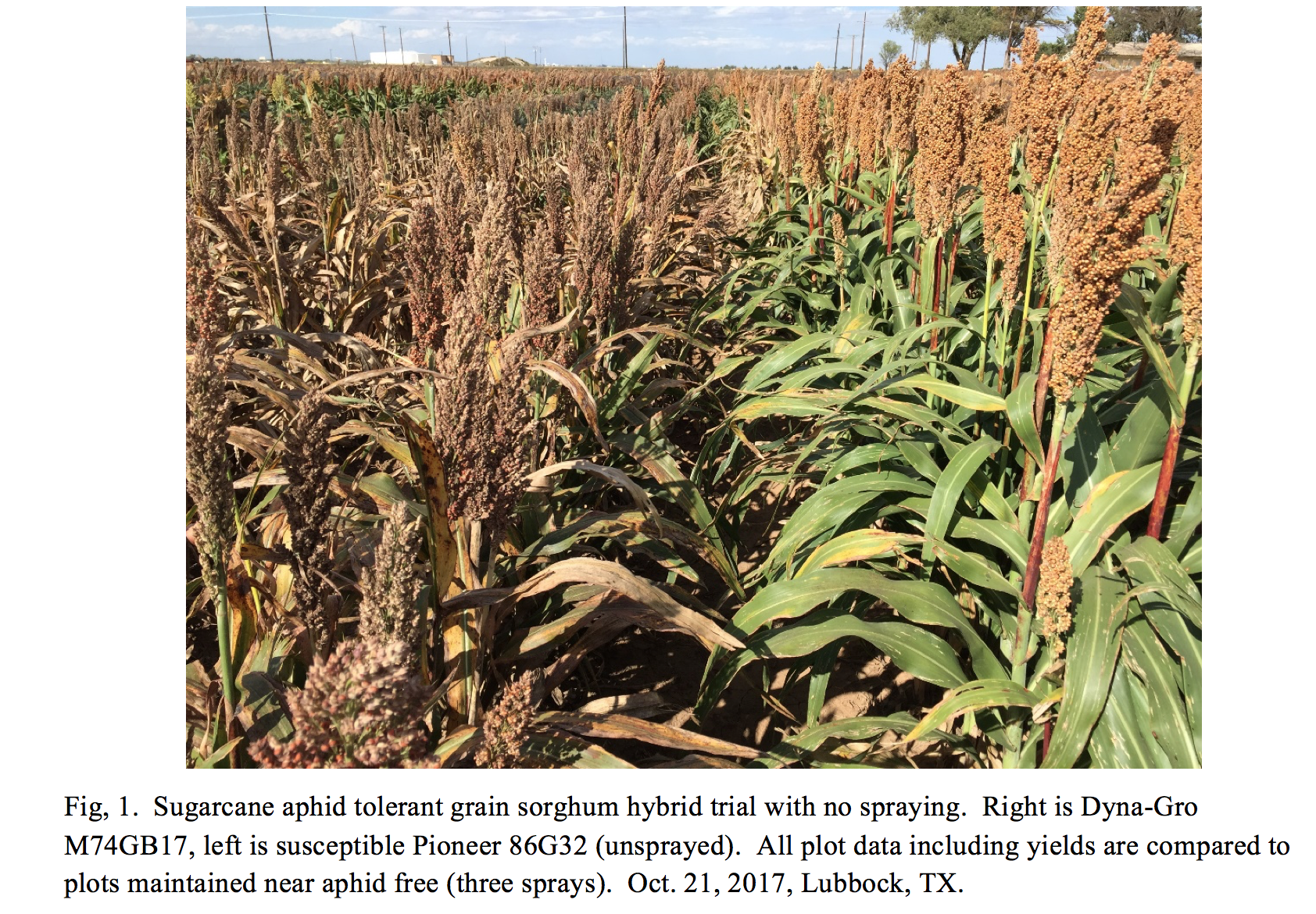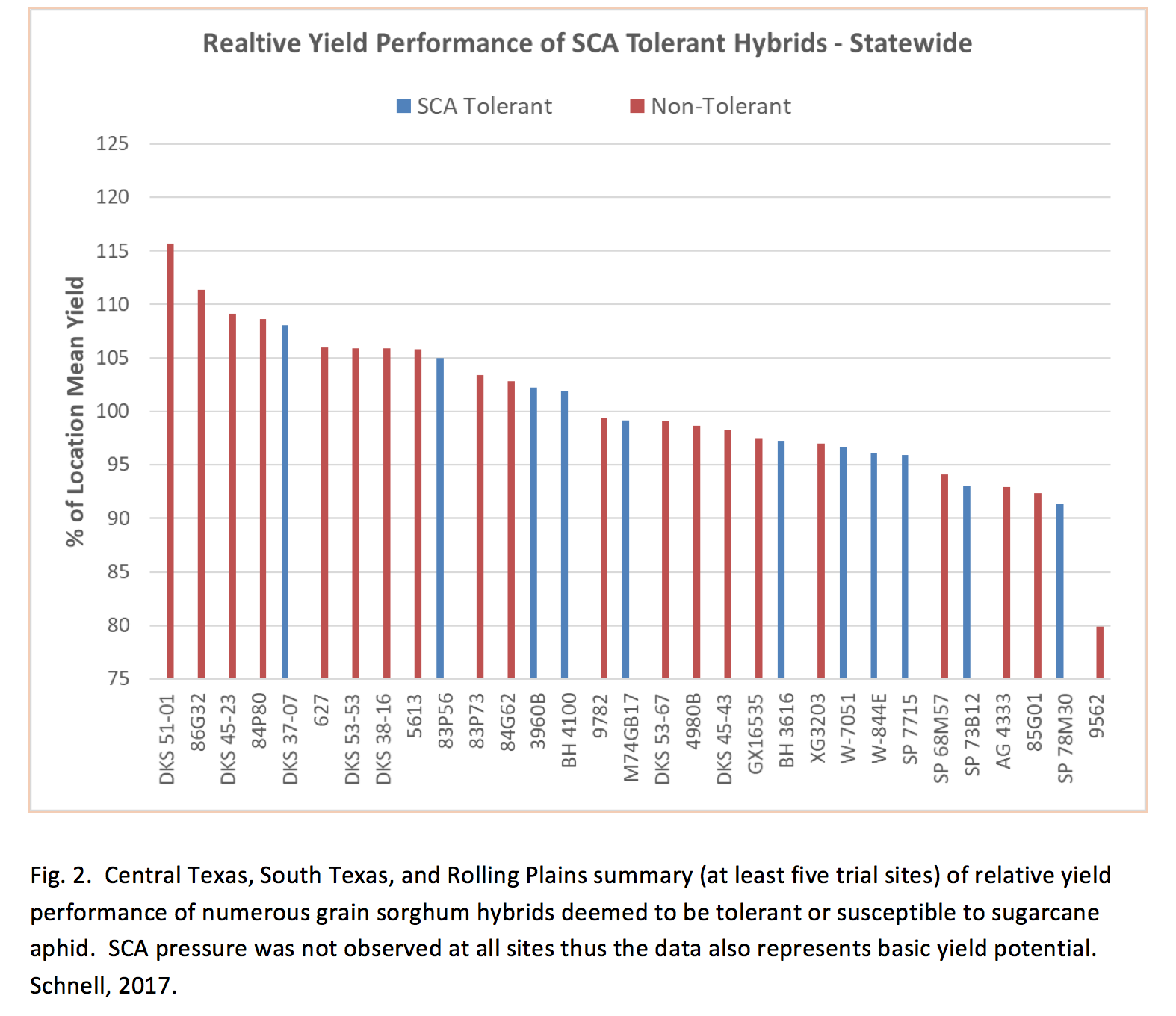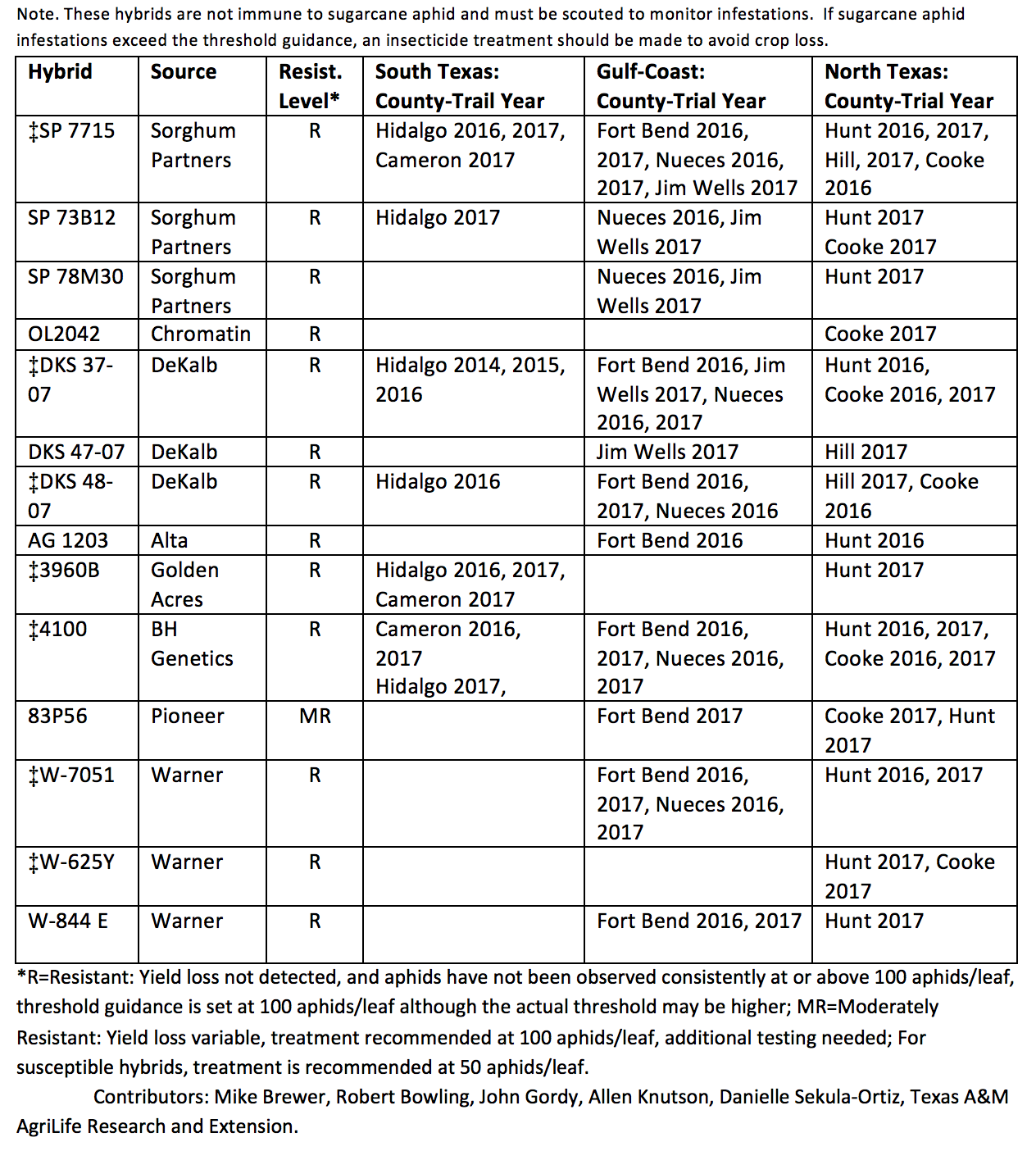This tip was provided by:
Calvin Trostle, Extension Agronomy, Lubbock, 806-746-6101, ctrostle@ag.tamu.edu
Allen Knutson, Extension Entomology, Dallas, (972) 952-9222, allen.knutson@ag.tamu.edu
Ron Schnell, Extension Agronomy/TAMU Dept. of Soil & Crop Sciences, College Station, (979) 845-2935, ronschnell@tamu.edu
Statewide
Grain Sorghum Hybrid Tolerance to Sugarcane Aphid
In this Sorghum Tip we will share results of different assessments of grain sorghum hybrids to SCA across the state. We have observed dramatic results of hybrid tolerance in many trials (Fig. 1). We will follow with specific in-season control measure later. In fact, many sorghum acres in South Texas are already planted, and seed decisions have been made, but much of the hybrid data below only became available this past week.
What will happen with sugarcane aphid in Texas in 2018?—No one can say for certain. We don’t know. But we do understand SCA well and that will help us all adjust to what SCA does in 2018, and we are in a far better position than we were in 2015.
Pre-plant Considerations for Potentially Reducing the Impact of SCA
Though most producers will think of insect control measures to involve scouting protocols, thresholds, insecticide choice and timing, method of application, spray carrier volume, and re-scouting (all to be discussed in greater detail in a future Sorghum Tip), here are early considerations. We thank Texas A&M AgriLife Extension entomologists for the suggestions:
- If planting grain sorghum it is our opinion that you should agree you will spray if science and extension recommendations call for it. Some producers in the Texas south plains in 2017 had good dryland sorghum, yield potential above average, but were adamant they would NOT spray. That strategy, if you want to call it that, cost some producers tens of thousands of dollars in lost yield. If you indeed plant grain sorghum but be unwilling to spray, then the following three points are especially important.
- Plant early. This may be most applicable in the High Plains where the cropping season could be underway for two months or more before potential arrival of SCA. Don’t plant so early to risk sickly seedlings from cool weather and late freezes, but a couple of weeks earlier planting vs. your norm enables your sorghum to be at more advanced growth stages before potential infestation may occur. For South Plains growers, this could mean planting about the last 7-10 days of April, or near May 1 if in the Panhandle. If the same pattern occurred in 2018 as last year around Lubbock, late April sorghum (medium and especially medium-early hybrids) was heading when SCA arrived. Larger plants can tolerate the SCA better compared to a few aphids on a three- or four-leaf stage seedling.
- Seed insecticide. AgriLife entomologists generally recommend that seed insecticide treatments help control SCA at least 30 days and may offer a reduced level of protection (suppression) for another couple of weeks. The cost of a comprehensive seed treatment with insecticide (also includes fungicide) may add $40-50/bag, but at ~5 lbs. seed per acre (about 65,000-70,000 seeds per acre), that is $4-5/acre. High Pains dryland seeding rates of ~30,000 seeds per acre would reduce added seed costs to $2/acre or less.
- Plant a sorghum hybrid with documented tolerance from independent sources. But know this: 1) all sorghum hybrids should be assumed susceptible to sugarcane aphid at some level, and must be scouted, 2) the ability of an individual hybrid to perform well in the presence of SCA may be influenced (diminished) by environmental conditions. Likewise, is a high yielding hybrid that is susceptible something to avoid? That depends. If you have a hybrid that outperforms on your farm, is it worth the more likely potential cost of spraying if it becomes necessary? (See Fig. 2.)
Grain Sorghum Hybrids Demonstrating SCA Tolerance in Texas
First, the data will be revisited to potentially update High Plains information so watch for more results in the next two Sorghum Tips. The criteria for the information below is multiple sites across more than one year where SCA infestation occurred. Probably the best trials are where sets of replicated plots are maintained under both sprayed (e.g., near aphid free) and unsprayed conditions. This enables a comparison of the two yields. Also, in our trials I (Trostle) have certainly noted that some hybrids that were deemed tolerant didn’t look like it, suffering significant damage. So, know that this is not take-it-to-the-bank assured SCA tolerance let alone resistance. There are also likely several hybrids that have comparable SCA tolerance but have not been tested enough to document tolerance.
From Ron Schnell, Soil & Crop Sciences, College Station:
Numerous replicated plot and strip trials, many with weekly counts of sugarcane aphids on lower and upper leaves.
Tolerant—
- Dekalb 37-07
- Pioneer 83P56 (long maturity)
- B&H Genetics BH4100, BH 3616,
- Golden Acres 3960B
- Warner Seed W-7501 (tall, similar to forage sorghum), W-844-E
- Sorghum Partners SP7715, SP73B12, SP78M30
- Alta AG1203
- Dyna-Gro M74GB17
From Allen Knutson & Extension Entomology Colleagues:
Beginning in 2014, Texas A&M AgriLife Extension and Research, with support from the Texas Grain Sorghum Producers Board, began to evaluate some of these hybrids in replicated field trials to confirm resistance to sugarcane aphid. Trials were conducted in the Rio Grande Valley, Gulf Coast and north Texas and compared the number of sugarcane aphids and leaf damage among the hybrids and to hybrids known to be susceptible to sugarcane aphid.
These trials confirmed resistance in 14 hybrids from seven different seed companies (Table 1). This list is not complete and these and other seed companies may have hybrids with resistance to sugarcane aphid.
Sugarcane aphid populations increase more slowly on these resistant hybrids compared to susceptible hybrids where thresholds for insecticide use have been set at 50 aphids per leaf. Also, damage is lower on resistant hybrids compared to susceptible hybrids. In these trials, resistant hybrids had fewer sugarcane aphids than susceptible hybrids and aphid infestations often remained below the treatment threshold of 50 aphids per leaf for susceptible hybrids, and rarely exceeded 100 aphids per leaf.
From Calvin Trostle, Soil & Crop Sciences, Lubbock (preliminary);
Results are limited, but initial evaluations (full evaluation by end of March) suggest:
- Stronger tolerance: Dekalb 48-07 (we are told it will not be released on commercial scale), Dyna-Gro M74GB17, Pioneer 85Y34 (sharply distinct results but only confirmed to date at one other location where it was planted, Altus, OK), Warner W-7051 (tall medium long hybrid that looks more like a forage sorghum).
- Moderate tolerance: Dekalb 37-07, Sorghum Partners SP7715.
Table 1. Grain sorghum hybrids identified as having some resistance to sugarcane aphid in field trials Conducted by Texas A&M AgriLife Research and Extension entomology, 2015-2017. See the Texas Sorghum Assn. “Sorghum Insider”, Feb. 20, 2017, for AgriLife entomology’s comments on suggested SCA thresholds above 50 aphids per leaf to as high as 200 aphids per leaf for strongly tolerant hybrids (for Central and South Texas, hybrids marked with ‡ have suggested aphid thresholds of 150-200 per leaf).











